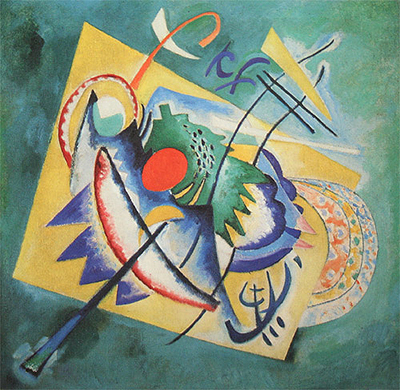Red Oval is dated at 1920, making it towards the start of Kandinsky's concentration on the use of precise shapes and lines within his work. There would be a geometric element to his output for several decades.
The red oval, as mentioned in the title, is placed fairly centrally, and the bright tone immediately captures your focus. It is set within a myriad of shapes which is placed upon a dark green background that varied in darkness. A large yellow rectangle is then balanced in the centre, and inside this the artist adds a whole load of detail with all manner of different shapes and colours. It is a busy artwork because of the way in which these items blend with each other, but later in his career he would start to keep these types of things fairly independent of each other. Many will attempt to make sense of these geometric shapes but by this stage of his career Kandinsky had reached such a high level of abstraction that it is very hard to identify and explain each part of this style of art.
The content found here will remind many of the work of Joan Miro in the latter part of his own career, by which time he had developed a form of icons that he would use across different paintings. One of these would be a bright red sun which feels very familiar with the content found here in Red Oval. He himself had earlier worked more traditionally but always desired to reject those movements and seek a new style of art, which he would eventually achieve. Some of the better examples of Miro's approach to this desire would be Bleu II, L'Oro dell' Azzurro and Catalan Landscape.
The painting can be found in the collection of The Solomon R. Guggenheim Museum in New York. The institution also has a number of impressive satellite galleries elsewhere too which help to put their huge collection on display to as many people as possible, all year round. They focus on contemporary art and have a number of Kandinsky paintings within their collection, as well as focusing on many who are strongly related to the career of this Russian innovator. Georges Braque, Paul Cezanne, Juan Gris and Paul Klee have notable artworks here, and they sum up the types of styles that can be found across the collection of this modern, forward-thinking institution. Their decision to spread into other nations has also allowed them to rotate their collection more effectively and allow others to see some of these paintings and sculptures for the first time.




